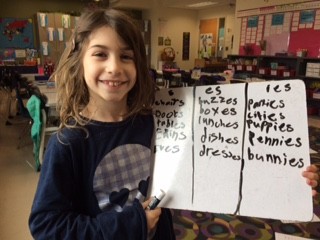Week 26
We had a wonderful week of learning in this spring-like weather!


Reading
The students are studying how to identify the author’s purpose for writing. We have looked at many different texts whose purposes range from being written to teach to being written to entertain! We began reading a biography on Helen Keller this week and the students are working on determining what information from this text they should include in a small report on her life. We will continue working on these skills next week.
Spelling
This week, I decided to change the plans and review how to make spell plural nouns. We have learned how to add “s”, “es”, and “ies” to the ends of words to make them plural but the students are having trouble remembering these rules. We played games and went on hunts around the classroom to find examples of plural nouns. Next week, we will learn how to spell silent vowel patterns, where the vowel makes a long sound. Examples of this pattern can be found in the words yellow and night.

Writing
We are practicing using our center time efficiently to meet deadlines. This is not easy because we’d like to write stories all day! 🙂 The students did an excellent job meeting their deadlines and completing their first drafts of their stories this week. They worked on rereading their work so they did not repeat themselves, moving their stories forward with details, showing their details instead of telling them, and wrapping up their stories with feelings! Whoa! There are so many things that writers have to keep track of in their heads, and next week the students will work on editing and revising their stories!
Vocabulary
The students reviewed our first six vocabulary lessons this week. Overall, we noticed that the words greedy, bare, and pale were the hardest to remember. Next week, the students will read a magazine article called Be An Outdoor Detective. Our vocabulary words from this article will be: Alarm, collect, damp, insect, plant, safe, scatter, soil, team, and tool.
Math
This week we practiced measuring to the nearest inch and centimeter. We learned that sometimes measurements don’t need to be exact, but they do need to be close. In these cases you will round up to the next centimeter or inch if you are at the halfway mark or higher, and you will round down if you are under the halfway mark. We also worked on collecting and organizing data. We measured our arm spans in inches and we did a “long jump” and measured it in centimeters. The students put all of this data into bar and line plot graphs. They found the mode (most popular number), median (middle number), and range (maximum – minimum number) of this data set. Here we are finding our arm spans and doing the long jump!
! 








